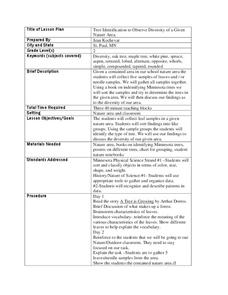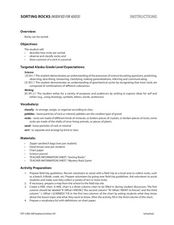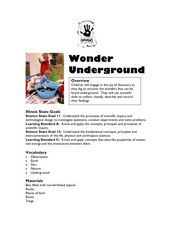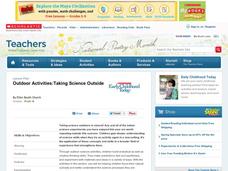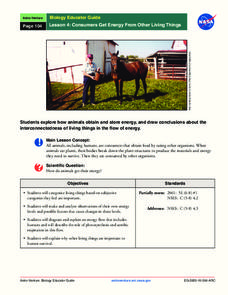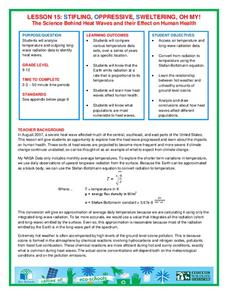Curated OER
Flower Power
Determine which plants are flowering plants with a helpful lab sheet. Kids first observe illustrations of different plants, such as a carnation and a fern, then decide which plants produce flowers, spores, or cones. Use magazine pictures...
Agriculture in the Classroom
Seed Match
Using this resource, your team of green thumbs discuss why plants are a part of a healthy diet and the different ways they are used in daily life. They then observe the characteristics of different seed as they attempt to match...
Science Friday
Colorful Chromosomes
Everything is in the genes. Individuals observe 14 different traits of themselves. Using pipe cleaners and beads, the learners create models of a chromosome representing their traits. The class then compares and contrasts everyone's...
Curated OER
Classification of Matter
This is a great worksheet with an infographic to assist your learners in categorizing matter into mixtures and non-mixtures. Information is given about the metric system of measurement. Your young students match 13 terms with their...
Curated OER
Sort Laboratory Practice
Eighth graders sort animals according to certain physical characteristics. For this science lesson, 8th graders explain the reason for such classification. They complete a worksheet individually at the end of the lesson.
Curated OER
Tree Identification to Observe Diversity of a Given Nature Area
In this tree identification instructional activity, 2nd graders read A Tree is Growing, discuss what makes up a forest, brainstorm characteristics of leaves, gather samples of leaves and examine their samples. Students will sort leaves...
Curated OER
Sorting Rocks
Students devise a rock word web and sort rocks by applying the categories they discuss.
Curated OER
Wonder Underground
Students classify and record objects they find "underground." In this observation instructional activity, students dig into bins filled with soil and encounter various objects such as bark, twigs, etc. Students classify their findings.
Curated OER
Lunch
First graders view and sort a display of fruits and vegetables by one characteristic. They listen as the teacher reads the story, "Lunch." Students identify items on the pages as living or nonliving, fruit or vegetable. Using magazines,...
Curated OER
Color Dots 2
Students develop simple observations. They observe bleeding of colored inks with water, to understand mixtures, and to make generalized inferences from their observations.
Curated OER
Look at those Leaves!
Students observe leaves for patterns and similarities. In this science activity, students sort through a pile of leaves to find patterns and take measurements. Students make leaf rubbings to view the details of the leaves.
Curated OER
Use Your Nose
Students explore how their senses work. In this senses lesson, students use the sense of smell to observe various spices. Students discuss their findings.
Curated OER
Fun Activities Using Seeds
Students analyze the size, shape, and form of several different seeds. In this all about seeds lesson plan, students complete four activities involving characteristics of seeds. Students observe the seeds, record information about the...
Curated OER
Comparing and Contrasting a Desert Reptile and a Rainforest Mammal
First graders compare and contrast two different type of animals while also making predictions, observations, and asking provocative questioning. In this compare and contrast lesson, 1st graders acquire knowledge about why some animals...
Curated OER
The Five Senses
Study various objects and help kindergarteners use their five senses to classify the objects. They are presented with various objects and then use their five senses to sort and classify the objects. Then they use a Visual Ranking Tool to...
Curated OER
Outdoor Activities: Taking Science Outside
Students participate in various outdoor science activities to enhance their observation, classification, and analysis skills. In this outdoor lesson, students begin by observing a tree from a straightforward angle, then from the...
Center for Learning in Action
Introduction to the States of Matter
Liquids, gases, and solids are the states of matter in which scholars investigate in a lesson plan that offers in-depth information and engaging activities that look into the three states and the changes their properties make when mixed...
Virginia Department of Education
Animal Phyla and Plant Divisions
Searched hours for an activity that allows individuals the ability to use multiple resources to learn about both plant and animal kingdoms? This discussion and activity provide pupils with the ability to visualize each organism...
Baylor College
Food for Kids
Immediately capture the attention of your class with the smell of freshly popped popcorn in the sixth lesson of this series on the needs of living things. Young scientists first use their senses to make and record observations of...
Curated OER
Answering a Research Question
Students explore beginning research skills. In this nonfiction comprehension and research instructional activity, students generate possible research questions to answer when given the book title of Animals of the Sea and Shore by Ann O....
NASA
Consumers Get Energy From Other Living Things
How do plants and animals get their food? Learn about where energy comes from, how animals store energy, and aerobic respiration, in a lesson that allows scholars to diagram energy flows.
National Wildlife Federation
Stifling, Oppressive, Sweltering, Oh My!
Looking for a hot date? Pick any day in August, statistically the hottest month in the United States. The 15th lesson plan in the series of 21 instructs pupils to investigate the August 2007 heat wave through NASA data, daily temperature...
Curated OER
Rock Sorting
First graders observe rocks, record their observations about the rocks and classify them according to their observations. As a class, 1st graders create a list of observable characteristics of rocks. They sort a group of rocks...
Curated OER
Science- Unit on Matter- Solids
Second graders identify and describe properties of matter.
They identify three forms of matter- solids, liquids, and gases with 100% accuracy. The student describes the properties of solid objects.





